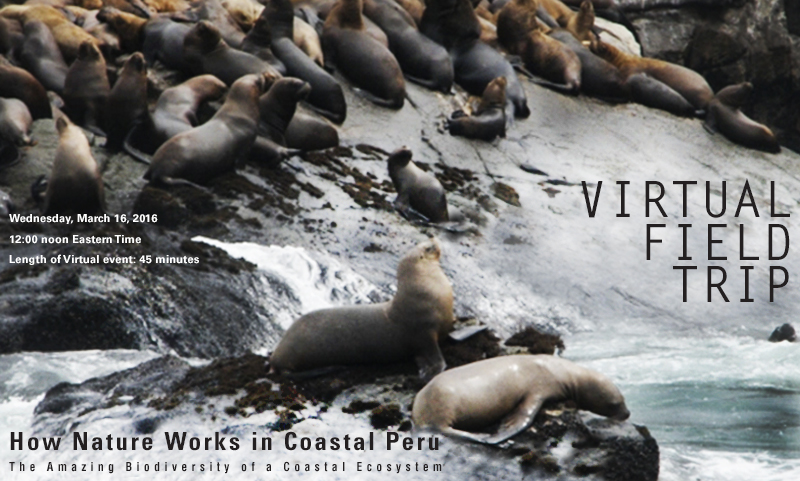Take your students to Peru for free (live on youtube on March 16th at Noon Eastern)! Your class will investigate the amazing biodiversity of a coastal ecosystem as they explore the Humboldt Current! On the trip students will also see sea birds, penguins and flamingos!
Along with fisheries scientist Matias Caillaux, they will travel by boat to an island that has more than 30,000 sea lions at a time! They will discover how the Humboldt Current pushes vital nutrients toward the surface and forms the "basis of a unique and abundant ecosystem." They will also learn the importance of protecting an ecosystem so its inhabitants and the region's fishing industry remain thriving.
This trip is a great opportunity to cover science and geography standards through problem-based learning. They will get to view one of the most productive ocean ecosystems in action!
Field Trip Information
How Nature Works in Coastal Peru: The Amazing Biodiversity of a Coastal Ecosystem
Subject focus: Science and Geography
Age Range: 3-8 (all viewers are welcomed!)
Date: Wednesday, March 16, 2016
Time: 12:00 noon Eastern Time
Length of Virtual event: 45 minutes
Link to register: https://www.natureworkseverywhere.org/#events/56b8d3c4c6435b2294b92fb0
Can't Watch the Virtual Field Trip on March 16th?
You can still attend the field trip by receiving the official YouTube viewing link, which you can use to watch anytime after the live event has concluded. The virtual field trip will also be optimized and posted at a later date on Vimeo. Once the Vimeo version is ready, you will receive the link in another newsletter and then you'll be able to watch the virutal field trip anytime on Vimeo or YouTube!
Interactive websites for the classroom with background:
Fishing for Tomorrow: The Artisanal Fishers of Ancón Story Map (pictured below)
Link to The Artisanal Fishers of Ancón Story Map: https://tnc.maps.arcgis.com/apps/MapJournal/?appid=0e99d43e82304b00bf30d2f47478a4b3
The Humboldt Current Ecosystem: How Earth Systems Influence Ocean Productivity and Biodiversity Story Map (pictured below)
Link to The Humboldt Current Ecosystem: https://tnc.maps.arcgis.com/apps/MapJournal/?appid=fd508c644a5b4cd3b4d2758a1ac07e91
Accompanying lesson with the virtual field trip: Fishing for a Future:
In this lesson students investigate sustainable fishing through a specific case study in Peru.
Provided:
Provided:
1. Interactive story maps that explore the Humboldt Current, El Nino, and artisanal fishing
2. Fisheries management activity using data
3. Socratic Seminar that explores the challenges of open access fishing areas
Includes downloads for the classroom
· Teacher Lesson Plan: Fishing for a Future (PDF & Word)
· Student Handout on Fisheries Management (PDF & Word)
· Student Handout on the Humboldt Current (PDF & Word)
· Student Handout: Anchoveta Socratic Seminar (PDF & Word)


















